Multi–Model Ensemble Approaches to Assessment of Effects of Local Climate Change on Water Resources of the Hotan River Basin in Xinjiang, China
Abstract
:1. Introduction
2. Study Area and Data
2.1. Study Area
2.2. Data
3. Methodology
3.1. Hydrological Modelling
3.2. Inter-Comparison and Evaluation of the Performance of GCMs
3.3. Downscaling Methods
3.3.1. Delta Method for Downscaling Precipitation and Temperature
3.3.2. Advanced Quantile Perturbation Method (wetQPM) for Downscaling Precipitation
- (1)
- Selected rainfall threshold intensity was used to define a wet day, e.g., >0.01 mm/day for this study.
- (2)
- For each calendar month, the number of counts of wet days for both GCM simulated and observed series was used. Afterwards, the change factor of wet day frequency was calculated.where and are the number of wet days for the GCM scenario and historical runs in mth month, respectively, is the wet day frequency change in mth month, N(m) is the number of wet day changes. For months where N(m) > 0, the number of N(m) dry days in that month is randomly selected and replaced by random wet day intensity from that month. When the N(m) < 0, the absolute value of N(m) wet days is selected randomly and replaced by zero. The changed observed time series include the wet day frequency changes in that area denoted as PNObs.
- (3)
- According to the wet day threshold, the GCM scenario time series quantiles were ranked as sx1 sx2 sxisxN; GCM historical series were ranked as hx1 hx2 hxihxN; the observed quantiles were ranked as ox1 ox2 oxioxN, where i is the rainfall intensity rank; that is, i = 1 for the highest rainfall intensity and i = N for the lowest rainfall intensity. Then, the quantile perturbation factors, Qpi, were calculated using the equation Qpi = sxi/hxi.
- (4)
- Based on the value of Qpi, the wet day intensity changes were applied to the new observed time series, PNobs, using Equation (13):
- (5)
- The new climate change signals were calculated between PFur,d and PObs,d and the new climate changes were compared with the change signals between the GCM scenario and the historical runs calculated in step (2).
- (6)
- Steps 2 to 5 were repeated until the generated value was small enough to be equivalent to the difference between steps (2) and (5). The climate change signals in step (5) were used as the future climate projections.
4. Results and Discussion
4.1. Results of Hydrological Modelling
4.2. The Performance of Each GCM Run
4.3. Precipitation and Temperature Trends
4.4. The Combined Effects of Both Precipitation and Temperature Input Variables
4.5. The Separate Effects of Precipitation and Temperature
5. Conclusions
- (1)
- Based on the statistical evaluation indices of discharge calibration as well as validation at TGZLK station, both the MIKE SHE and SWAT models demonstrated acceptable performance in the Hotan River Basin when driven by TRMM daily rainfall data.
- (2)
- The precipitation is projected to experience an overall increase with rates ranging between −1.2% to 32.7% (−3.1% to 31.8%) at HT (PS) station. The dry season is predicted to have relatively higher increases than the wet season while a slightly decreasing trend was predicted for July (August and September). The projected average temperature was expected to increase by 1.60–2.61 °C (1.66–2.58 °C) at HT (PS) station. The projected Tmax increased slightly more when compared with Tmin during summer and autumn, which represents the predicted warmer daytime temperatures.
- (3)
- The structure of the hydrological models strongly influences the simulated effects of climate change. MIKE SHE model was found to be more sensitive to simulated precipitation as well as temperature than the SWAT model. Discharge will increase with an increase of precipitation in both models. With an increase in temperature, the discharge significantly decreased in the MIKE SHE model, while it increased in the SWAT model. However, the increase in magnitude became smaller and even tended to decrease with a sustained increase in temperature.
- (4)
- The snowline was predicted to increase in elevation by ca. 200 m with a loss of accumulated snow at 4.2–6.2 km elevation. The evapotranspiration rate will increase significantly by 7.4% to 31.3%. Climate change is predicted to lead to stronger changes in peak flow than in the total and low flow. The semi-distributed SWAT model has obvious limitations when focusing on the peak flow response to climate change when compared with the MIKE SHE model.
Acknowledgments
Author Contributions
Conflicts of Interest
References
- Pall, P.; Aina, T.; Stone, D.A.; Stott, P.A.; Nozawa, T.; Hilberts, A.G.; Lohmann, D.; Allen, M.R. Anthropogenic greenhouse gas contribution to flood risk in England and Wales in autumn 2000. Nature 2011, 470, 382–385. [Google Scholar] [CrossRef] [PubMed]
- Carter, J.G.; Cavan, G.; Connelly, A.; Guy, S.; Handley, J.; Kazmierczak, A. Climate change and the city: Building capacity for urban adaptation. Prog. Plan. 2015, 95, 1–66. [Google Scholar] [CrossRef] [Green Version]
- IPCC. Climate Change 2013: The Physical Science Basis. Contribution of Working Group I to the Fifth Assessment Report of the Intergovernmental Panel on Climate Change; Stocker, T.F., Qin, D., Plattner, G.-K., Tignor, M., Allen, S.K., Boschung, J., Nauels, A., Xia, Y., Bex, V., Midgley, P.M., Eds.; Cambridge University Press: Cambridge, UK, 2013. [Google Scholar]
- Abbaspour, K.C.; Faramarzi, M.; Ghasemi, S.S.; Yang, H. Assessing the impact of climate change on water resources in Iran. Water Resour. Res. 2009, 45, W10434. [Google Scholar] [CrossRef]
- Vicuna, S.; Dracup, J. The evolution of climate change impact studies on hydrology and water resources in California. Clim. Chang. 2007, 82, 327–350. [Google Scholar] [CrossRef]
- Liu, Z.; Xu, Z.; Huang, J.; Charles, S.P.; Fu, G. Impacts of climate change on hydrological processes in the headwater catchment of the Tarim River Basin, China. Hydrol. Process. 2010, 24, 196–208. [Google Scholar] [CrossRef]
- Wang, B.; Zhang, M.; Wei, J.; Wang, S.; Li, S.; Ma, Q.; Li, X.; Pan, S. Changes in extreme events of temperature and precipitation over Xinjiang, Northwest China, during 1960–2009. Quat. Int. 2013, 298, 141–151. [Google Scholar] [CrossRef]
- Ma, Z.; Kang, S.; Zhang, L.; Tong, L.; Su, X. Analysis of impacts of climate variability and human activity on streamflow for a river basin in arid region of Northwest China. J. Hydrol. 2008, 352, 239–249. [Google Scholar] [CrossRef]
- Lioubimtseva, E.; Cole, R.; Adams, J.; Kapustin, G. Impacts of climate and land-cover changes in arid lands of Central Asia. J. Arid Environ. 2005, 62, 285–308. [Google Scholar] [CrossRef]
- Lioubimtseva, E.; Henebry, G.M. Climate and environmental change in arid Central Asia: Impacts, vulnerability, and adaptations. J. Arid Environ. 2009, 73, 963–977. [Google Scholar] [CrossRef]
- Yang, L.; Zhang, Q. Effects of the North Atlantic oscillation on the summer rainfall anomalies in Xinjiang. Chin. J. Atmos. Sci. 2008, 32, 1187–1196. [Google Scholar]
- Chen, Y.; Xu, C.; Hao, X.; Li, W.; Chen, Y.; Zhu, C.; Ye, Z. Fifty-year climate change and its effect on annual runoff in the Tarim River Basin, China. Quat. Int. 2009, 208, 53–61. [Google Scholar]
- Zhang, Q.; Xu, C.-Y.; Tao, H.; Jiang, T.; Chen, Y.D. Climate changes and their impacts on water resources in the arid regions: A case study of the Tarim River Basin, China. Stoch. Environ. Res. Risk Assess. 2010, 24, 349–358. [Google Scholar] [CrossRef]
- Barnett, T.P.; Adam, J.C.; Lettenmaier, D.P. Potential impacts of a warming climate on water availability in snow-dominated regions. Nature 2005, 438, 303–309. [Google Scholar] [CrossRef] [PubMed]
- Charlton, R.; Fealy, R.; Moore, S.; Sweeney, J.; Murphy, C. Assessing the impact of climate change on water supply and flood hazard in Ireland using statistical downscaling and hydrological modelling techniques. Clim. Chang. 2006, 74, 475–491. [Google Scholar] [CrossRef]
- Steele-Dunne, S.; Lynch, P.; McGrath, R.; Semmler, T.; Wang, S.; Hanafin, J.; Nolan, P. The impacts of climate change on hydrology in Ireland. J. Hydrol. 2008, 356, 28–45. [Google Scholar] [CrossRef]
- Hessami, M.; Gachon, P.; Ouarda, T.B.M.J.; St-Hilaire, A. Automated regression-based statistical downscaling tool. Environ. Model. Softw. 2008, 23, 813–834. [Google Scholar] [CrossRef]
- Ahmed, K.F.; Wang, G.; Silander, J.; Wilson, A.M.; Allen, J.M.; Horton, R.; Anyah, R. Statistical downscaling and bias correction of climate model outputs for climate change impact assessment in the US Northeast. Glob. Planet. Chang. 2013, 100, 320–332. [Google Scholar] [CrossRef]
- Ouyang, F.; Lü, H.; Zhu, Y.; Zhang, J.; Yu, Z.; Chen, X.; Li, M. Uncertainty analysis of downscaling methods in assessing the influence of climate change on hydrology. Stoch. Environ. Res. Risk Assess. 2014, 28, 991–1010. [Google Scholar] [CrossRef]
- Xu, C.Y. Climate change and hydrologic models: A review of existing gaps and recent research developments. Water Resour. Manag. 1999, 13, 369–382. [Google Scholar] [CrossRef]
- Hassan, Z.; Shamsudin, S.; Harun, S. Application of sdsm and lars-wg for simulating and downscaling of rainfall and temperature. Theor. Appl. Climatol. 2013, 116, 243–257. [Google Scholar] [CrossRef]
- Mahmood, R.; Jia, S. An extended linear scaling method for downscaling temperature and its implication in the Jhelum River Basin, Pakistan, and India, using CMIP5 GCMs. Theor. Appl. Climatol. 2016. [Google Scholar] [CrossRef]
- Liu, T.; Willems, P.; Pan, X.; Bao, A.M.; Chen, X.; Veroustraete, F.; Dong, Q. Climate change impact on water resource extremes in a headwater region of the Tarim Basin in China. Hydrol. Earth Syst. Sci. 2011, 15, 6593–6637. [Google Scholar] [CrossRef]
- Liu, J.; Luo, M.; Liu, T.; Bao, A.; De Maeyer, P.; Feng, X.; Chen, X. Local climate change and the impacts on hydrological processes in an arid alpine catchment in Karakoram. Water 2017, 9, 344. [Google Scholar] [CrossRef]
- Onyutha, C.; Tabari, H.; Rutkowska, A.; Nyeko-Ogiramoi, P.; Willems, P. Comparison of different statistical downscaling methods for climate change rainfall projections over the Lake Victoria Basin considering CMIP3 and CMIP5. J. Hydro-Environ. Res. 2016, 12, 31–45. [Google Scholar] [CrossRef]
- Miles, E.L.; Elsner, M.M.; Littell, J.S.; Binder, L.W.; Lettenmaier, D.P. Assessing regional impacts and adaptation strategies for climate change: The Washington climate change impacts assessment. Clim. Chang. 2010, 102, 9–27. [Google Scholar] [CrossRef]
- Wilby, R.L.; Hay, L.E.; Gutowski, W.J.; Arritt, R.W.; Takle, E.S.; Pan, Z.; Leavesley, G.H.; Clark, M.P. Hydrological responses to dynamically and statistically downscaled climate model output. Geophys. Res. Lett. 2000, 27, 1199–1202. [Google Scholar] [CrossRef]
- Nyeko-Ogiramoi, P.; Willems, P.; Ngirane-Katashaya, G.; Ntegeka, V. Nonparametric statistical downscaling of precipitation from global climate models. In Climate Models; InTech Europe, University Campus STeP Ri.: Slavka Krautzeka, Croatia, 2012; pp. 109–136. [Google Scholar]
- Liu, J.; Liu, T.; Bao, A.; De Maeyer, P.; Kurban, A.; Chen, X. Response of hydrological processes to input data in high alpine catchment: An assessment of the Yarkant River Basin in China. Water 2016, 8, 181. [Google Scholar] [CrossRef]
- Huang, Y.; Chen, X.; Bao, A.; Ma, Y. Distributed hydrological modeling in Kaidu Basin: MIKE-SHE model calibration and uncertainty estimation. J. Glaciol. Geocryol. 2010, 32, 567–572. [Google Scholar]
- Deus, D.; Gloaguen, R.; Krause, P. Water balance modeling in a semi-arid environment with limited in situ data using remote sensing in Lake Manyara, East African Rift, Tanzania. Remote Sens. 2013, 5, 1651–1680. [Google Scholar] [CrossRef]
- Ushio, T.; Sasashige, K.; Kubota, T.; Shige, S.; Okamoto, K.I.; Aonashi, K.; Inoue, T.; Takahashi, N.; Iguchi, T.; Kachi, M. A kalman filter approach to the global satellite mapping of precipitation (GSMAP) from combined passive microwave and infrared radiometric data. J. Meteorol. Soc. Jpn. Ser. II 2009, 87, 137–151. [Google Scholar] [CrossRef]
- Katsanos, D.; Retalis, A.; Michaelides, S. Validation of a high-resolution precipitation database (CHIRPS) over cyprus for a 30-year period. Atmos. Res. 2016, 169, 459–464. [Google Scholar] [CrossRef]
- Kummerow, C.; Barnes, W.; Kozu, T.; Shiue, J.; Simpson, J. The tropical rainfall measuring mission (TRMM) sensor package. J. Atmos. Ocean. Technol. 1998, 15, 809–817. [Google Scholar] [CrossRef]
- Joyce, R.J.; Janowiak, J.E.; Arkin, P.A.; Xie, P. Cmorph: A method that produces global precipitation estimates from passive microwave and infrared data at high spatial and temporal resolution. J. Hydrometeorol. 2004, 5, 487–503. [Google Scholar] [CrossRef]
- Li, X.-H.; Zhang, Q.; Xu, C.-Y. Suitability of the TRMM satellite rainfalls in driving a distributed hydrological model for water balance computations in Xinjiang Catchment, Poyang Lake Basin. J. Hydrol. 2012, 426, 28–38. [Google Scholar] [CrossRef]
- Su, F.; Hong, Y.; Lettenmaier, D.P. Evaluation of TRMM multisatellite precipitation analysis (TMPA) and its utility in hydrologic prediction in the La Plata Basin. J. Hydrometeorol. 2008, 9, 622–640. [Google Scholar] [CrossRef]
- Zulkafli, Z.; Buytaert, W.; Onof, C.; Manz, B.; Tarnavsky, E.; Lavado, W.; Guyot, J.-L. A comparative performance analysis of TRMM 3b42 (TMPA) versions 6 and 7 for hydrological applications over Andean–Amazon River Basins. J. Hydrometeorol. 2014, 15, 581–592. [Google Scholar] [CrossRef]
- Xue, X.; Hong, Y.; Limaye, A.S.; Gourley, J.J.; Huffman, G.J.; Khan, S.I.; Dorji, C.; Chen, S. Statistical and hydrological evaluation of TRMM-based multi-satellite precipitation analysis over the Wangchu Basin of bhutan: Are the latest satellite precipitation products 3B42V7 ready for use in Ungauged Basins? J. Hydrol. 2013, 499, 91–99. [Google Scholar] [CrossRef]
- Li, L.; Ngongondo, C.S.; Xu, C.-Y.; Gong, L. Comparison of the global TRMM and WFD precipitation datasets in driving a large-scale hydrological model in Southern Africa. Hydrol. Res. 2013, 44, 770–788. [Google Scholar] [CrossRef]
- Maggioni, V.; Meyers, P.C.; Robinson, M.D. A review of merged high-resolution satellite precipitation product accuracy during the tropical rainfall measuring mission (TRMM) era. J. Hydrometeorol. 2016, 17, 1101–1117. [Google Scholar] [CrossRef]
- Luo, M.; Liu, T.; Huang, Y.; Meng, F.; Liu, J.; Tian, L. Daily flow modeling in Hotan River Basin under future climate change scenarios. J. Water Resour. Water Eng. 2016, 27, 11–17. [Google Scholar]
- Luo, M.; Liu, T.; Meng, F.; Duan, Y.; Huang, Y.; Frankl, A.; De Maeyer, P. Proportional coefficient method applied to TRMM rainfall data: Case study of hydrological simulations of the Hotan River Basin (China). J. Water Clim. Chang. 2017. [Google Scholar] [CrossRef]
- Xue, X.; Mi, Y.; Li, Z.; Chen, Y. Long-term trends and sustainability analysis of air temperature and precipitation in the Hotan River Basin. Resour. Sci. 2008, 30, 1833–1838. [Google Scholar]
- Jie, W.; Jun, W.; Xin, S. Analysis of water change along Hotan River Basin. J. Water Resour. Water Eng. 2013, 32, 142–148. [Google Scholar]
- Huang, L.; Shen, B.; Song, X.; Li, H.; Luo, G. Characteristics of surface water resources in the Hotan River Basin. J. Shenyang Agric. Univ. 2004, 873, 550–584. [Google Scholar]
- Chen, Y.; Takeuchi, K.; Xu, C.; Chen, Y.; Xu, Z. Regional climate change and its effects on river runoff in the Tarim Basin, China. Hydrol. Process. 2006, 20, 2207–2216. [Google Scholar] [CrossRef]
- Huang, L.; Shen, B.; Zhang, G. Study on the suitable scale for Hotan Oasis, Xinjiang. J. Arid Land Resour. Environ. 2008, 22, 1–4. [Google Scholar]
- China Meteorological Data Sharing Service System. Available online: http://data.cma.cn/ (accessed on 4 August 2017).
- Kharin, V.V.; Zwiers, F.; Zhang, X.; Wehner, M. Changes in temperature and precipitation extremes in the CMIP5 ensemble. Clim. Chang. 2013, 119, 345–357. [Google Scholar] [CrossRef]
- Kawase, H.; Nagashima, T.; Sudo, K.; Nozawa, T. Future changes in tropospheric ozone under representative concentration pathways (RCPS). Geophys. Res. Lett. 2011, 38, L05801. [Google Scholar] [CrossRef]
- Huang, Y.; Wang, F.; Li, Y.; Cai, T. Multi-model ensemble simulation and projection in the climate change in the Mekong River Basin. Part I: Temperature. Environ. Monit. Assess. 2014, 186, 7513–7523. [Google Scholar] [CrossRef] [PubMed]
- Arnold, J.G.; Srinivasan, R.; Muttiah, R.S.; Williams, J.R. Large area hydrologic modeling and assessment part I: Model development. J. Water Resour. Water Eng. 1998, 34, 73–89. [Google Scholar] [CrossRef]
- Abbott, M.B.; Bathurst, J.C.; Cunge, J.A.; O’Connell, P.E.; Rasmussen, J. An introduction to the european hydrological system—Systeme hydrologique europeen,”SHE”, 1: History and philosophy of a physically-based, distributed modelling system. J. Hydrol. 1986, 87, 45–59. [Google Scholar] [CrossRef]
- Easton, Z.M.; Fuka, D.R.; Walter, M.T.; Cowan, D.M.; Schneiderman, E.M.; Steenhuis, T.S. Re-conceptualizing the soil and water assessment tool (SWAT) model to predict runoff from variable source areas. J. Hydrol. 2008, 348, 279–291. [Google Scholar] [CrossRef]
- Marek, G.W.; Gowda, P.H.; Evett, S.R.; Baumhardt, R.L.; Brauer, D.K.; Howell, T.A.; Marek, T.H.; Srinivasan, R. Calibration and validation of the swat model for predicting daily et over irrigated crops in the texas high plains using lysimetric data. Am. Soc. Agric. Biol. Eng. 2016, 59, 611–622. [Google Scholar]
- Yen, H.; White, M.J.; Jeong, J.; Arabi, M.; Arnold, J.G. Evaluation of alternative surface runoff accounting procedures using swat model. Int. J. Agric. Biol. Eng. 2015, 8, 64–68. [Google Scholar]
- Larsen, M.A.D.; Refsgaard, J.; Drews, M.; Butts, M.B.; Jensen, K.; Christensen, J.; Christensen, O. Results from a full coupling of the hirham regional climate model and the MIKE SHE hydrological model for a Danish Catchment. Hydrol. Earth Syst. Sci. 2014, 18, 4733–4749. [Google Scholar] [CrossRef] [Green Version]
- Fang, G.; Yang, J.; Chen, Y.; Zhang, S.; Deng, H.; Liu, H.; De Maeyer, P. Climate change impact on the hydrology of a typical watershed in the Tianshan Mountains. Adv. Meteorol. 2015. [Google Scholar] [CrossRef]
- Golmohammadi, G.; Prasher, S.; Madani, A.; Rudra, R. Evaluating three hydrological distributed watershed models: MIKE-SHE, APEX, SWAT. Hydrology 2014, 1, 20–39. [Google Scholar] [CrossRef]
- Neitsch, S.L.; Arnold, J.G.; Kiniry, J.R.; Williams, J.R. Soil and Water Assessment Tool Theoretical Documentation Version 2009; Texas Water Resources Institute: Texas, TX, USA, 2011. [Google Scholar]
- Neitsch, S.; Arnold, J.; Kiniry, J.E.A.; Srinivasan, R.; Williams, J. Soil and water assessment tool user’s manual: Version 2000. Available online: http://swat.tamu.edu/media/1294/swatuserman.pdf (accessed on 4 August 2017).
- DHI. MIKE 11, A Modelling System for Rivers and Channels, Reference Manual; DHI Water&Environment: Horsholm, Denmark, 2008. [Google Scholar]
- Kalantari, Z.; Lyon, S.W.; Folkeson, L.; French, H.K.; Stolte, J.; Jansson, P.-E.; Sassner, M. Quantifying the hydrological impact of simulated changes in land use on peak discharge in a small catchment. Sci. Total Environ. 2014, 466, 741–754. [Google Scholar] [CrossRef] [PubMed]
- Teng, J.; Jakeman, A.; Vaze, J.; Croke, B.; Dutta, D.; Kim, S. Flood inundation modelling: A review of methods, recent advances and uncertainty analysis. Environ. Model. Softw. 2017, 90, 201–216. [Google Scholar] [CrossRef]
- Tang, C.; Yi, Y.; Yang, Z.; Sun, J. Risk forecasting of pollution accidents based on an integrated bayesian network and water quality model for the south to north water transfer project. Ecol. Eng. 2016, 96, 109–116. [Google Scholar] [CrossRef]
- Nash, J.; Sutcliffe, J. River flow forecasting through conceptual models part I—A discussion of principles. J. Hydrol. 1970, 10, 282–290. [Google Scholar] [CrossRef]
- Moriasi, D.N.; Arnold, J.G.; Van Liew, M.W.; Bingner, R.L.; Harmel, R.D.; Veith, T.L. Model evaluation guidelines for systematic quantification of accuracy in watershed simulations. Trans. ASABE 2007, 50, 885–900. [Google Scholar] [CrossRef]
- Baguis, P.; Roulin, E.; Willems, P.; Ntegeka, V. Climate change scenarios for precipitation and potential evapotranspiration over Central Belgium. Theor. Appl. Clim. 2010, 99, 273–286. [Google Scholar] [CrossRef]
- Gan, R.; Luo, Y.; Zuo, Q.; Sun, L. Effects of projected climate change on the glacier and runoff generation in the Naryn River Basin, Central Asia. J. Hydrol. 2015, 523, 240–251. [Google Scholar] [CrossRef]
- Taylor, K.E. Summarizing multiple aspects of model performance in a single diagram. J. Geophys. Res.: Atmos. 2001, 106, 7183–7192. [Google Scholar] [CrossRef]
- Griggs, D.J.; Noguer, M. Climate change 2001: The scientific basis. Contribution of working group I to the third assessment report of the intergovernmental panel on climate change. Weather 2002, 57, 267–269. [Google Scholar] [CrossRef]
- Covey, C.; AchutaRao, K.M.; Cubasch, U.; Jones, P.; Lambert, S.J.; Mann, M.E.; Phillips, T.J.; Taylor, K.E. An overview of results from the coupled model intercomparison project. Glob. Planet. Chang. 2003, 37, 103–133. [Google Scholar] [CrossRef]
- Hori, M.E.; Ueda, H. Impact of global warming on the East Asian winter monsoon as revealed by nine coupled atmosphere-ocean GCMs. Geophys. Res. Lett. 2006, 33, L03713. [Google Scholar] [CrossRef]
- Li, J.L.; Waliser, D.; Stephens, G.; Lee, S.; L’Ecuyer, T.; Kato, S.; Loeb, N.; Ma, H.Y. Characterizing and understanding radiation budget biases in CMIP3/CMIP5 GCMs, contemporary GCM, and reanalysis. J. Geophys. Res.: Atmos. 2013, 118, 8166–8184. [Google Scholar] [CrossRef]
- Stratton, R.; Stirling, A. Improving the diurnal cycle of convection in GCMs. Q. J. R. Meteorol. Soc. 2012, 138, 1121–1134. [Google Scholar] [CrossRef]
- Sabeerali, C.; Ramu Dandi, A.; Dhakate, A.; Salunke, K.; Mahapatra, S.; Rao, S.A. Simulation of boreal summer intraseasonal oscillations in the latest CMIP5 coupled GCMs. J. Geophys. Res.: Atmos. 2013, 118, 4401–4420. [Google Scholar] [CrossRef]
- Li, J.L.; Waliser, D.; Chen, W.T.; Guan, B.; Kubar, T.; Stephens, G.; Ma, H.Y.; Deng, M.; Donner, L.; Seman, C. An observationally based evaluation of cloud ice water in CMIP3 and CMIP5 GCMs and contemporary reanalyses using contemporary satellite data. J. Geophys. Res.: Atmos. 2012, 117, D16105. [Google Scholar] [CrossRef]
- Diaz-Nieto, J.; Wilby, R.L. A comparison of statistical downscaling and climate change factor methods: Impacts on low flows in the River Thames, United Kingdom. Clim. Chang. 2005, 69, 245–268. [Google Scholar] [CrossRef]
- Hay, L.E.; Wilby, R.L.; Leavesley, G.H. A comparison of delta change and downscaled gcm scenarios for three mounfainous basins in the United States. J. Am. Water Resour. Assoc. 2000, 36, 387–397. [Google Scholar] [CrossRef]
- Ntegeka, V.; Baguis, P.; Roulin, E.; Willems, P. Developing tailored climate change scenarios for hydrological impact assessments. J. Hydrol. 2014, 508, 307–321. [Google Scholar] [CrossRef]
- Liu, T.; Willems, P.; Feng, X.W.; Li, Q.; Huang, Y.; Bao, A.M.; Chen, X.; Veroustraete, F.; Dong, Q.H. On the usefulness of remote sensing input data for spatially distributed hydrological modelling: Case of the Tarim River Basin in China. Hydrol. Process. 2012, 26, 335–344. [Google Scholar] [CrossRef]
- Fang, G.H.; Yang, J.; Chen, Y.N.; Zammit, C. Comparing bias correction methods in downscaling meteorological variables for a hydrologic impact study in an arid area in China. Hydrol. Earth Syst. Sci. 2015, 19, 2547–2559. [Google Scholar] [CrossRef] [Green Version]
- Bokke, A.S.; Taye, M.T.; Willems, P.; Siyoum, S.A. Validation of general climate models (GCMs) over upper Blue Nile River Basin, Ethiopia. Atmos. Clim. Sci. 2017, 7, 65–75. [Google Scholar] [CrossRef]
- Hamlet, A.F.; Salathé, E.P.; Carrasco, P. Statistical downscaling techniques for global climate model simulations of temperature and precipitation with application to water resources planning studies. Columbia Basin Clim. Chang. Scenar. Proj. (CBCCSP) Rep. 2010. Available online: https://digital.lib.washington.edu/researchworks/bitstream/handle/1773/38428/2010-5.pdf?sequence=1 (accessed on 4 August 2017).
- Abdulla, F.; Eshtawi, T.; Assaf, H. Assessment of the impact of potential climate change on the water balance of a semi-arid watershed. Water Resour. Manag. 2009, 23, 2051–2068. [Google Scholar] [CrossRef]
- Christensen, N.S.; Wood, A.W.; Voisin, N.; Lettenmaier, D.P.; Palmer, R.N. The effects of climate change on the hydrology and water resources of the Colorado River Basin. Clim. Chang. 2004, 62, 337–363. [Google Scholar] [CrossRef]
- Liu, J.; Liu, T.; Bao, A.; De Maeyer, P.; Feng, X.; Miller, S.N.; Chen, X. Assessment of different modelling studies on the spatial hydrological processes in an arid alpine catchment. Water Resour. Manag. 2016, 30, 1757–1770. [Google Scholar] [CrossRef]
- Kienzler, P.M.; Naef, F. Subsurface storm flow formation at different hillslopes and implications for the ‘old water paradox’. Hydrol. Process. 2008, 22, 104–116. [Google Scholar] [CrossRef]
- Swarowsky, A.; Dahlgren, R.; O’Geen, A. Linking subsurface lateral flowpath activity with streamflow characteristics in a semiarid headwater catchment. Soil Sci. Soc. Am. J. 2012, 76, 532–547. [Google Scholar] [CrossRef]
- Thompson, J.; Sørenson, H.R.; Gavin, H.; Refsgaard, A. Application of the coupled MIKE SHE/MIKE 11 modelling system to a lowland wet grassland in Southeast England. J. Hydrol. 2004, 293, 151–179. [Google Scholar] [CrossRef]
- Lv, J.; Zhang, X.; Shen, B.; Huang, L. Variation trend and primary driving factors of the annual runoff in Hetian River. Shuili Fadian Xuebao (J. Hydroelectr. Eng.) 2010, 29, 165–169. [Google Scholar]
- Mote, P.W.; Hamlet, A.F.; Clark, M.P.; Lettenmaier, D.P. Declining mountain snowpack in Western North America. Bull. Am. Meteorol. Soc. 2005, 86, 39–49. [Google Scholar] [CrossRef]
- Stewart, I.T.; Cayan, D.R.; Dettinger, M.D. Changes in snowmelt runoff timing in Western North America under abusiness as usual’climate change scenario. Clim. Chang. 2004, 62, 217–232. [Google Scholar] [CrossRef]
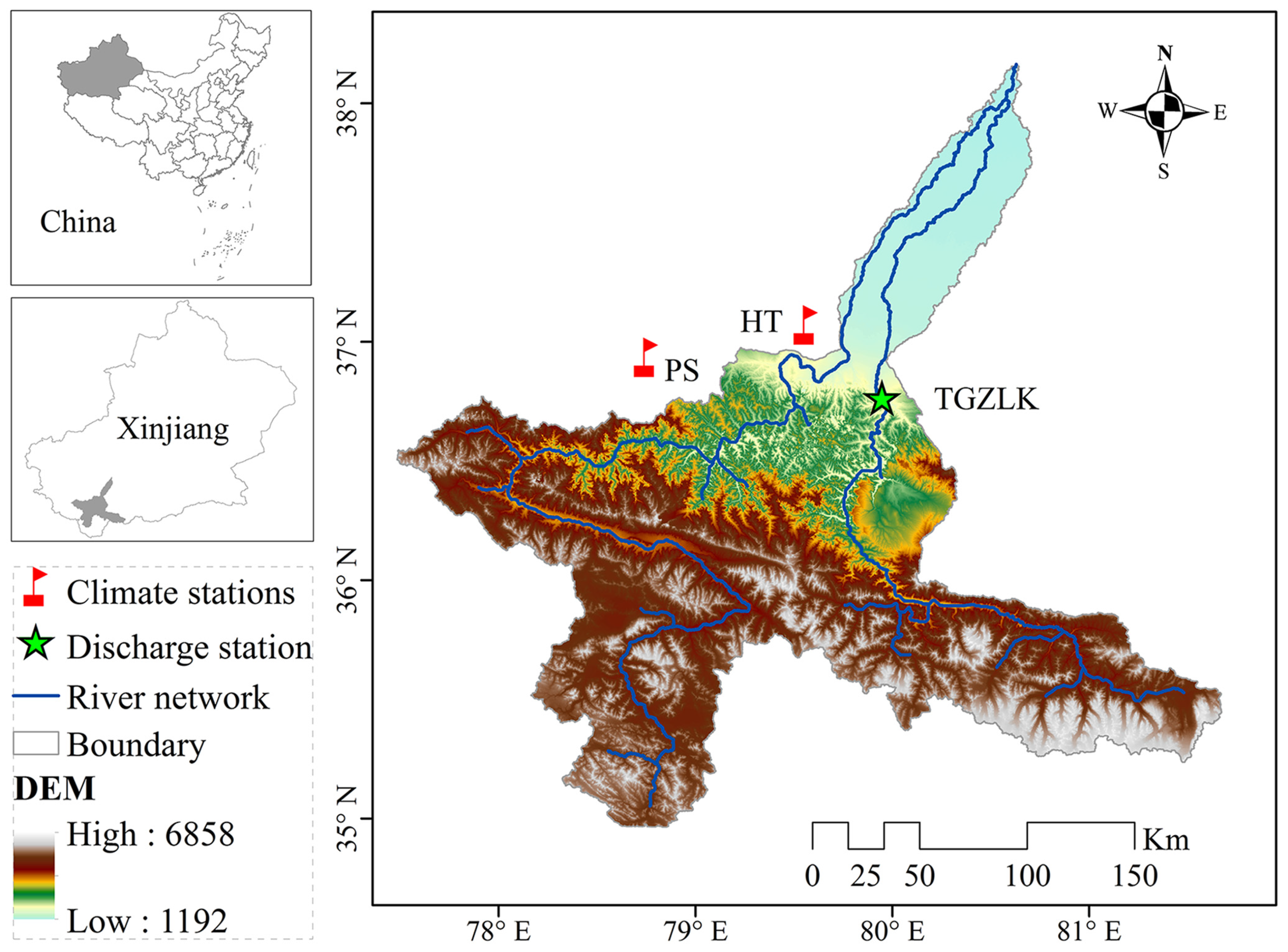
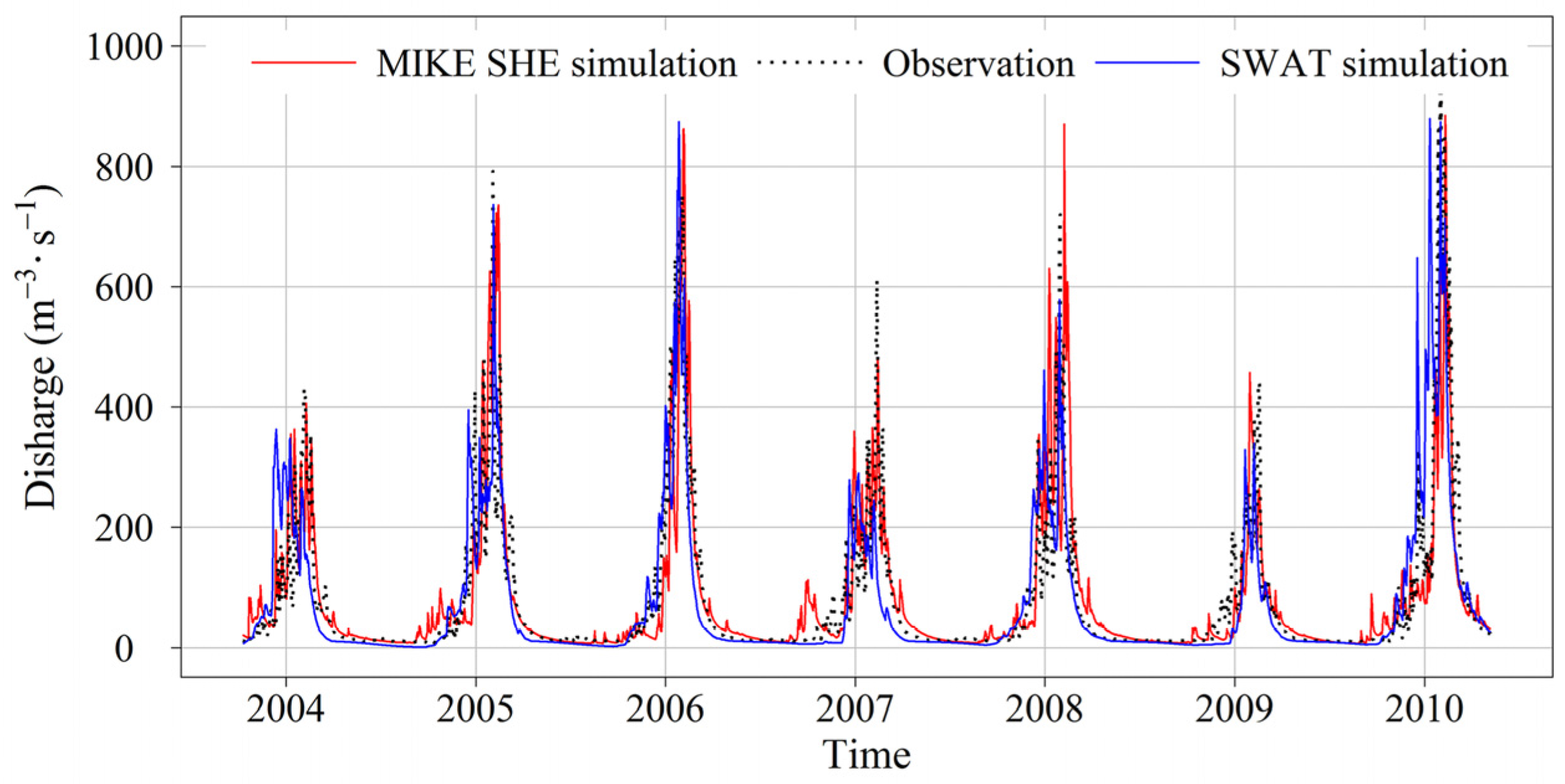

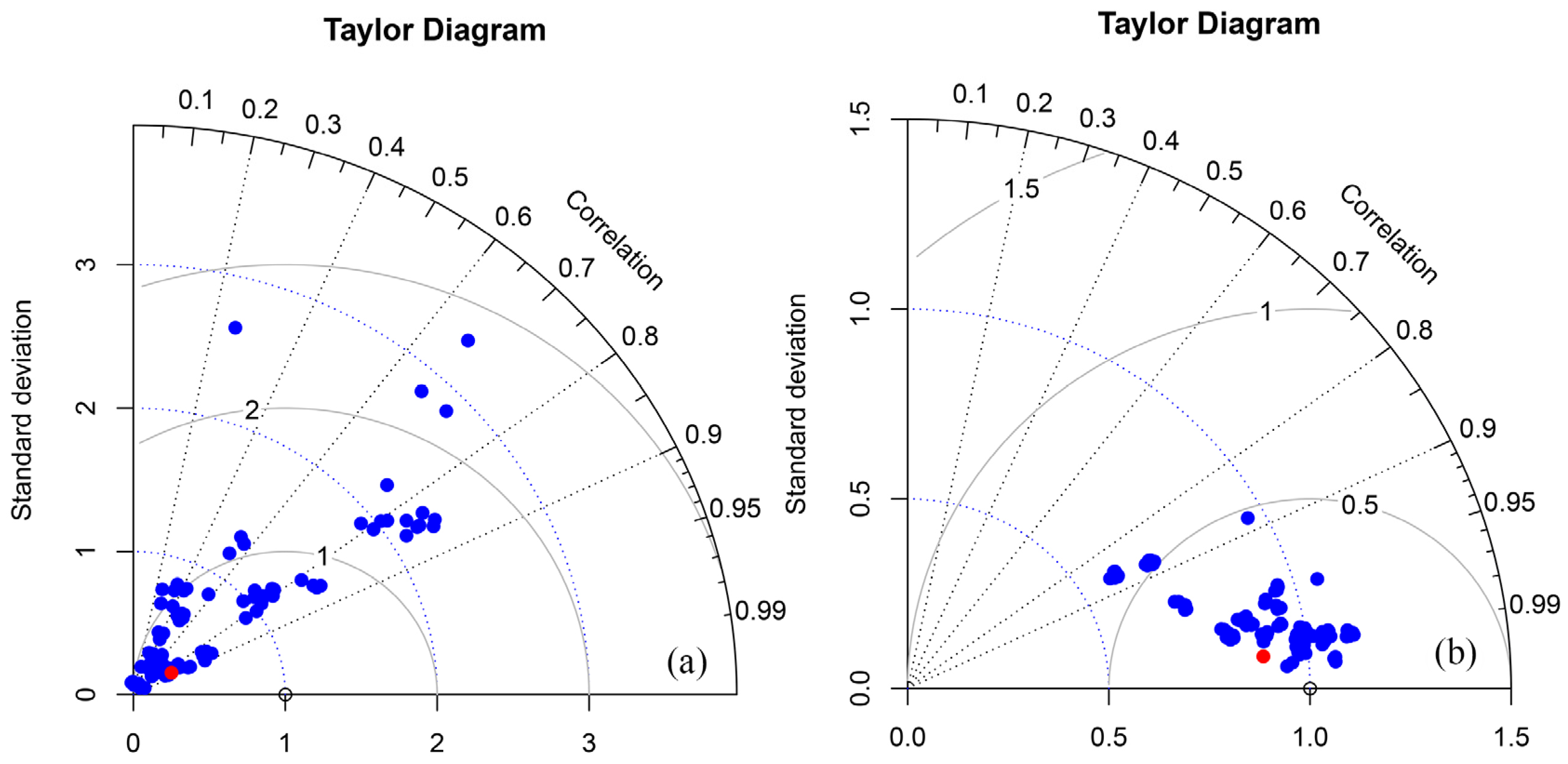
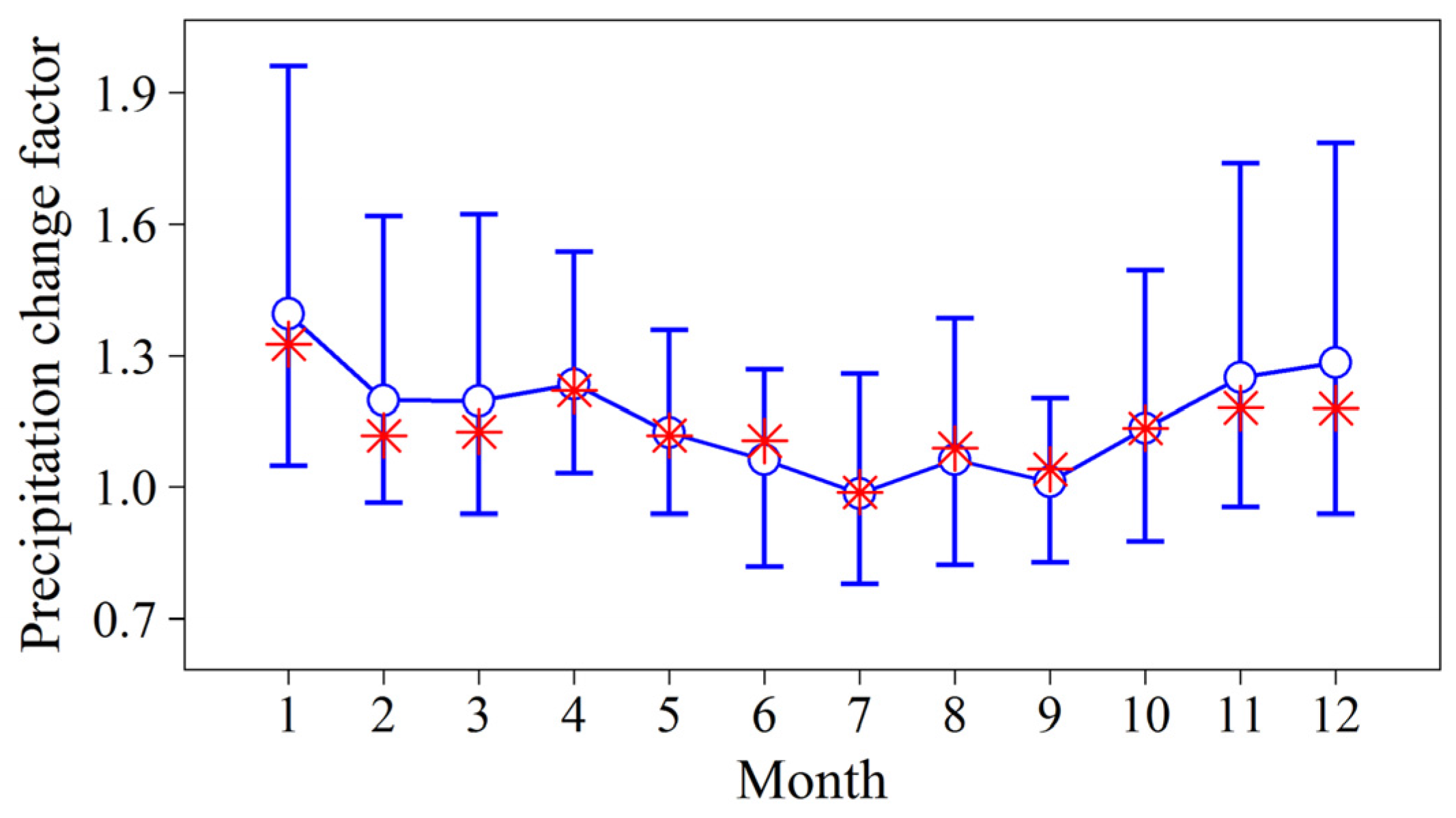

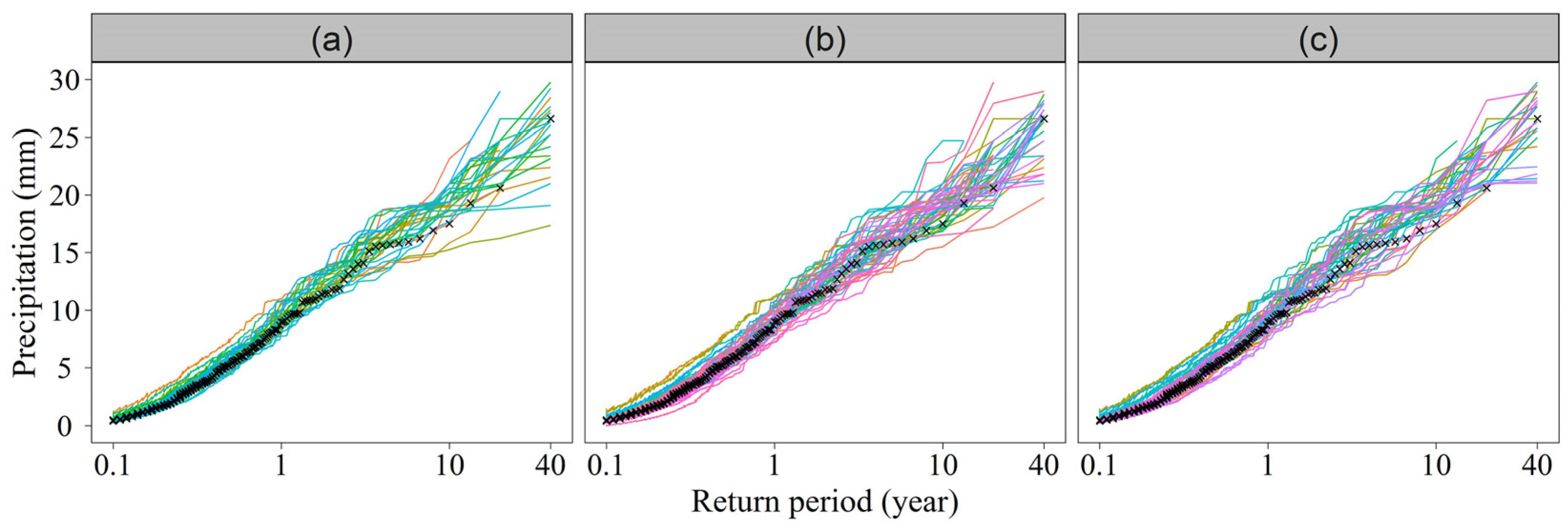
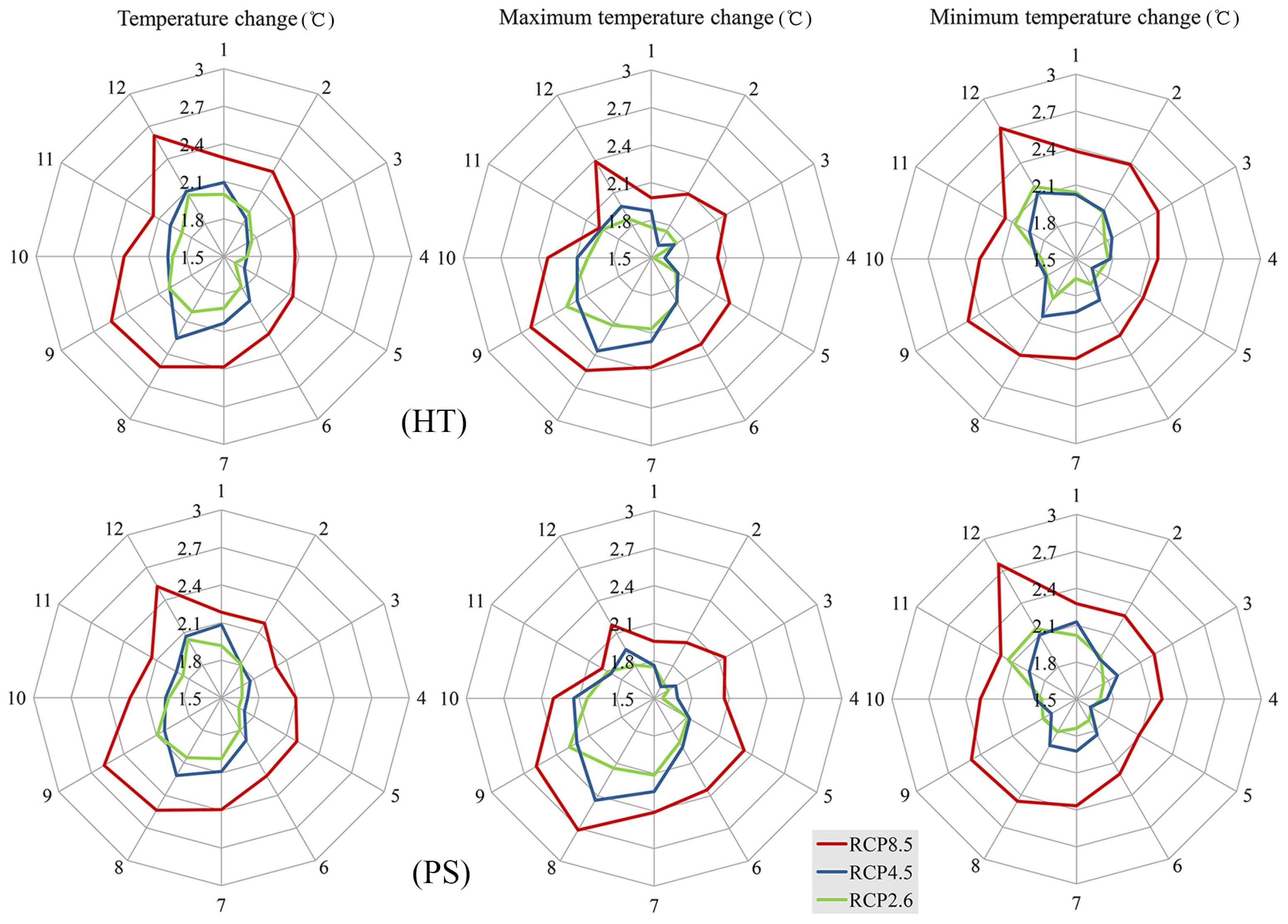
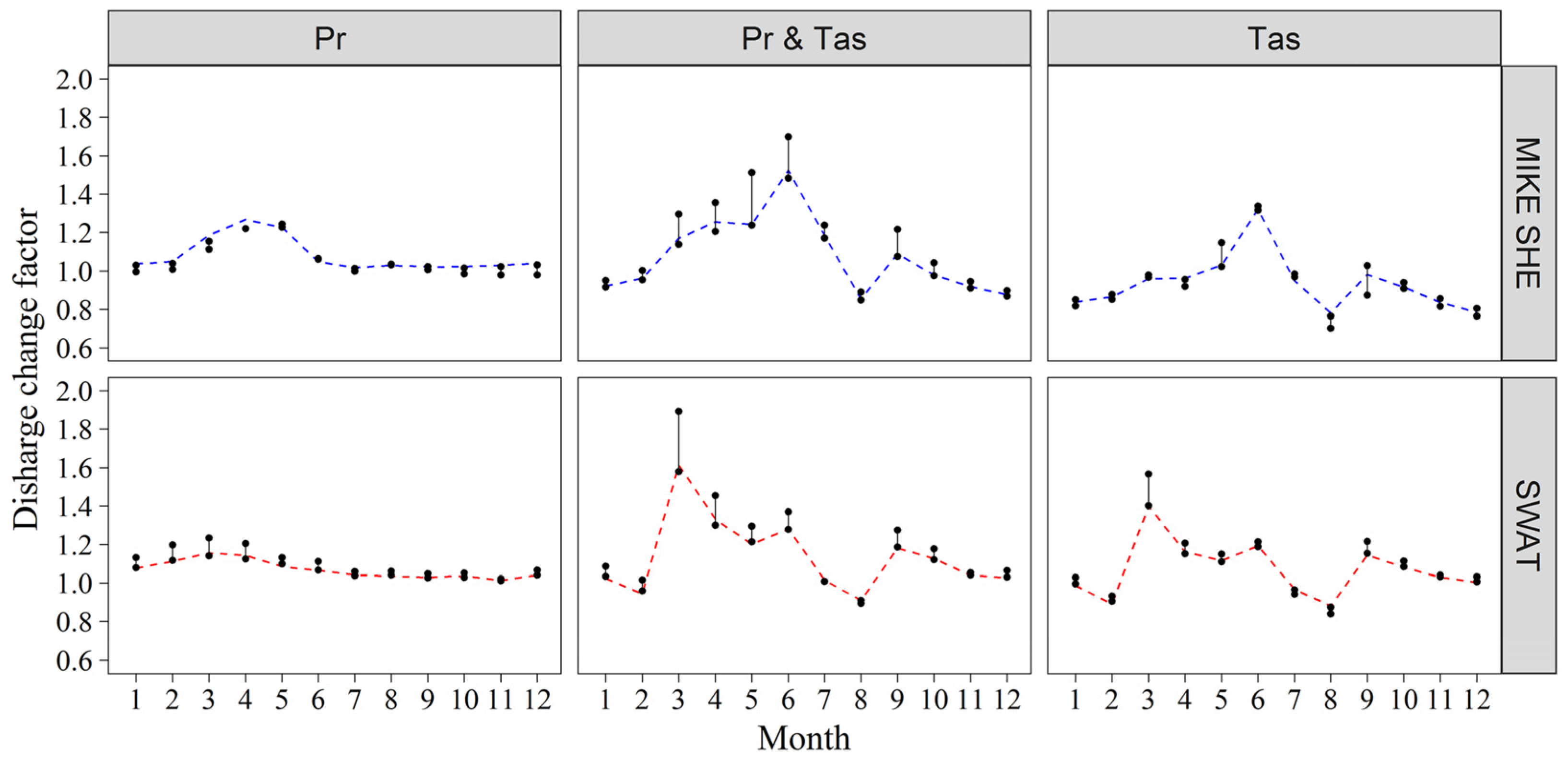
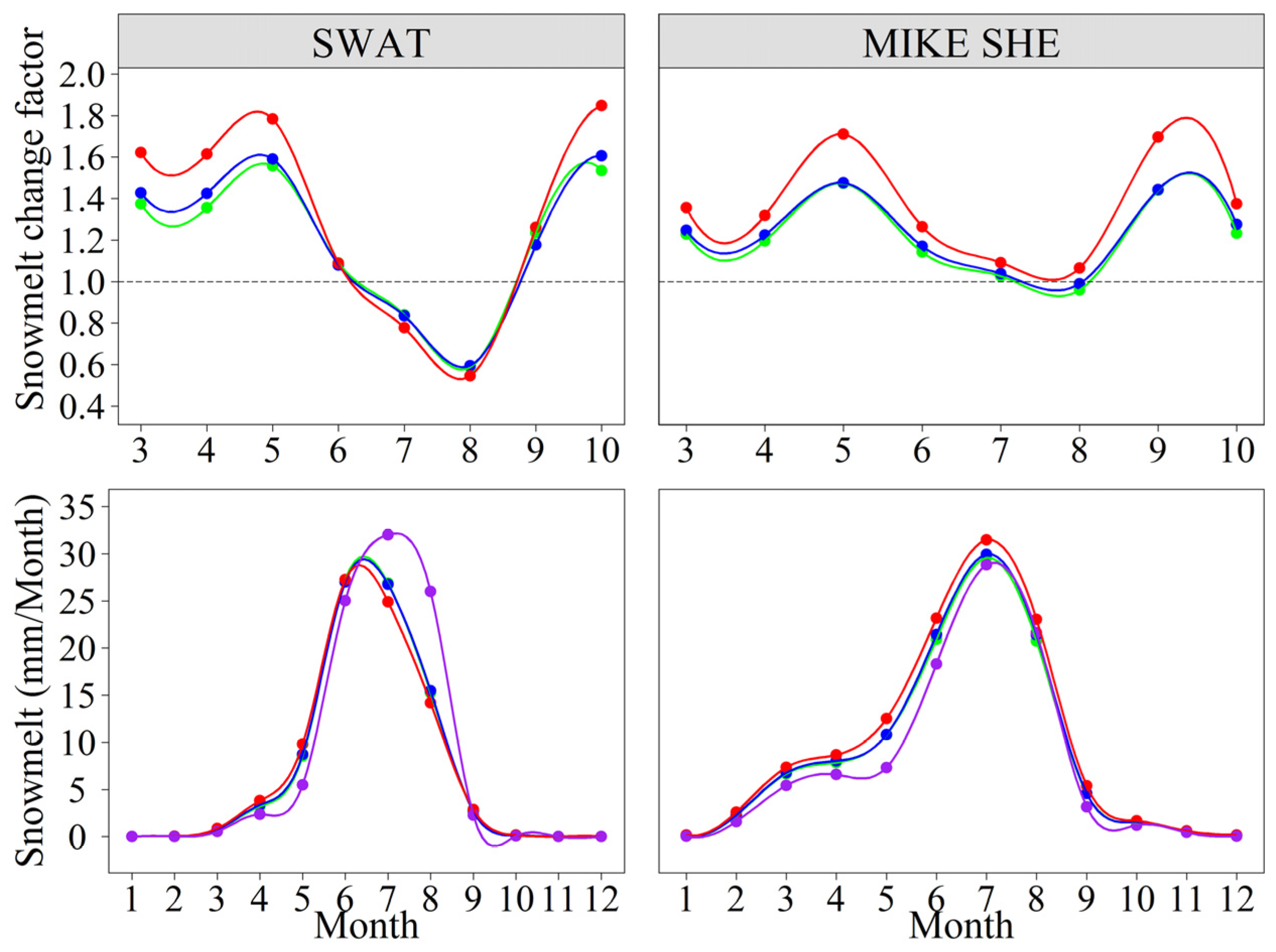
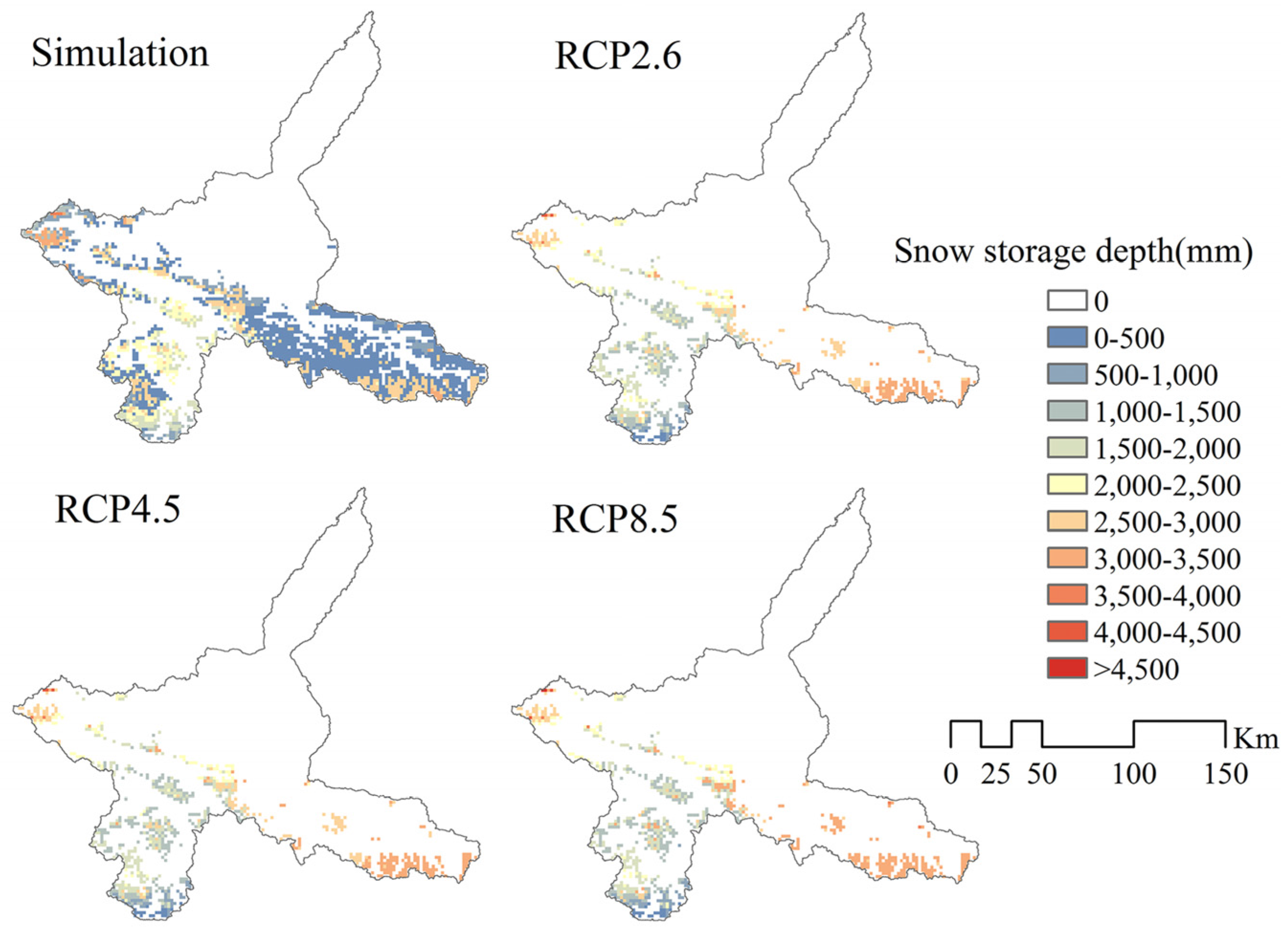
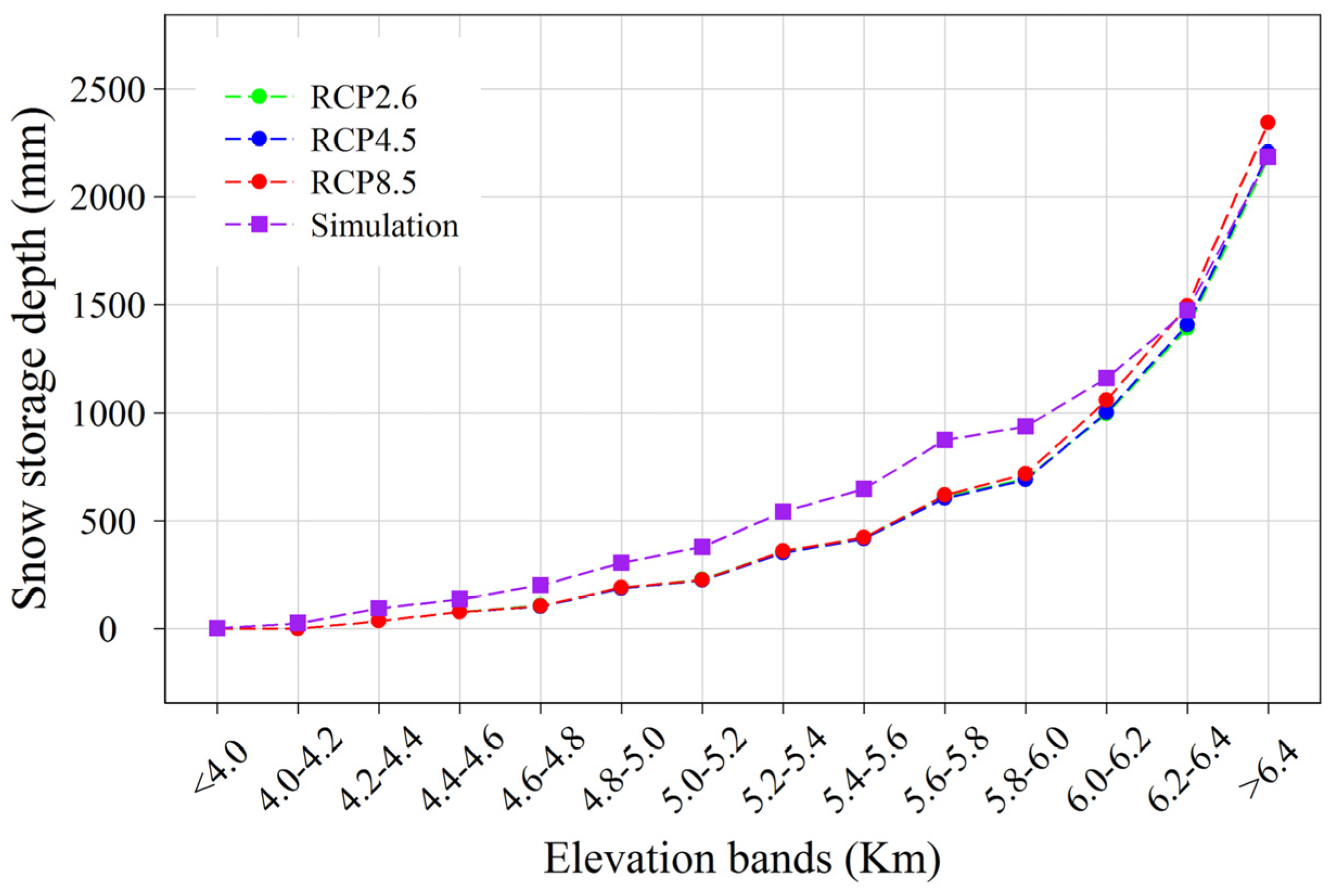
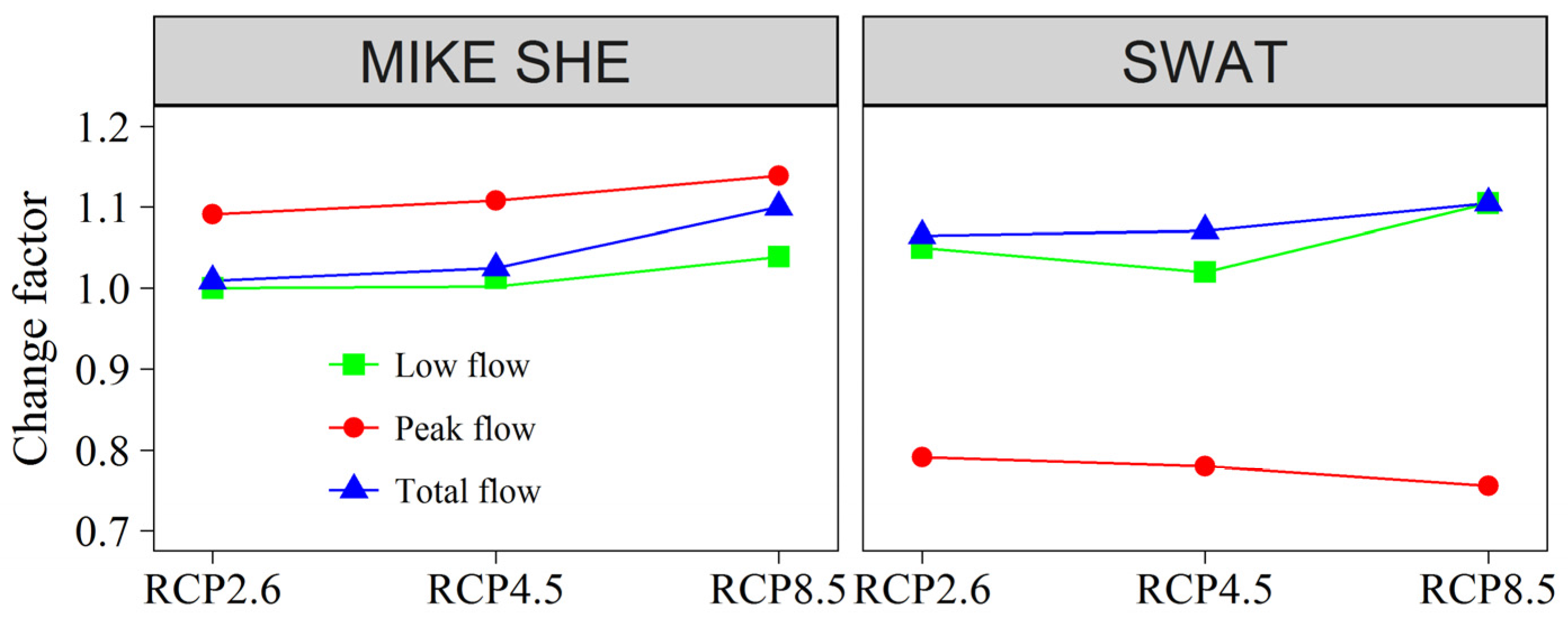

| Time Scale | Simulation | SWAT Results | MIKE SHE Results | ||||
|---|---|---|---|---|---|---|---|
| R2 | NS | RE | R2 | NS | RE | ||
| Daily | Calibration | 0.85 | 0.71 | 9% | 0.82 | 0.66 | −11% |
| Validation | 0.87 | 0.76 | 3% | 0.89 | 0.62 | 15% | |
| Monthly | Calibration | 0.93 | 0.87 | 9% | 0.93 | 0.86 | −11% |
| Validation | 0.92 | 0.84 | 3% | 0.97 | 0.83 | 15% | |
| Stations | Parameter | RCP2.6 | RCP4.5 | RCP8.5 |
|---|---|---|---|---|
| HT | P (%) | −0.4–14.2 | 0.9–19.0 | −1.2–32.7 |
| Tas () | 1.60–2.07 | 1.68–2.26 | 2.07–2.61 | |
| Tmax () | 1.52–2.28 | 1.61–2.36 | 1.98–2.61 | |
| Tmin () | 1.66–2.18 | 1.65–2.12 | 2.13–2.73 | |
| PS | P (%) | 1.4–23.1 | −3.1–21.7 | 0.1–31.8 |
| Tas () | 1.66–2.09 | 1.71–2.22 | 2.00–2.58 | |
| Tmax () | 1.57–2.28 | 1.61–2.44 | 1.96–2.71 | |
| Tmin () | 1.64–2.16 | 1.63–2.13 | 2.08–2.77 |
| Model | Parameter | RCP2.6 | RCP4.5 | RCP8.5 |
|---|---|---|---|---|
| MIKE SHE | P (%) | 7.27 | 7.40 | 11.53 |
| Tas () | 1.89 | 1.93 | 2.25 | |
| Q/P | 0.80 | 1.00 | 1.29 | |
| Q/Tas | −3.64 | −3.96 | −4.52 | |
| SWAT | Tmax () | 1.85 | 1.88 | 2.32 |
| Tmin () | 1.88 | 1.94 | 2.30 | |
| Q/P | 0.73 | 0.73 | 0.73 | |
| Q/Tmax | 1.20 | 1.31 | 1.03 | |
| Q/Tmin | 1.22 | 1.34 | 1.00 |
© 2017 by the authors. Licensee MDPI, Basel, Switzerland. This article is an open access article distributed under the terms and conditions of the Creative Commons Attribution (CC BY) license (http://creativecommons.org/licenses/by/4.0/).
Share and Cite
Luo, M.; Meng, F.; Liu, T.; Duan, Y.; Frankl, A.; Kurban, A.; De Maeyer, P. Multi–Model Ensemble Approaches to Assessment of Effects of Local Climate Change on Water Resources of the Hotan River Basin in Xinjiang, China. Water 2017, 9, 584. https://doi.org/10.3390/w9080584
Luo M, Meng F, Liu T, Duan Y, Frankl A, Kurban A, De Maeyer P. Multi–Model Ensemble Approaches to Assessment of Effects of Local Climate Change on Water Resources of the Hotan River Basin in Xinjiang, China. Water. 2017; 9(8):584. https://doi.org/10.3390/w9080584
Chicago/Turabian StyleLuo, Min, Fanhao Meng, Tie Liu, Yongchao Duan, Amaury Frankl, Alishir Kurban, and Philippe De Maeyer. 2017. "Multi–Model Ensemble Approaches to Assessment of Effects of Local Climate Change on Water Resources of the Hotan River Basin in Xinjiang, China" Water 9, no. 8: 584. https://doi.org/10.3390/w9080584






